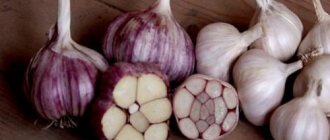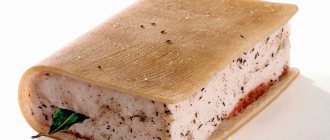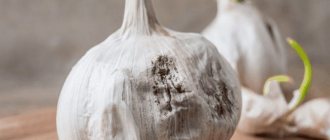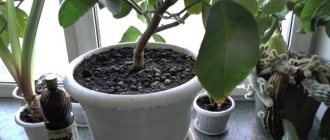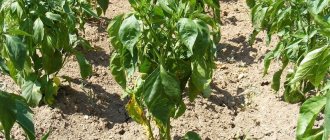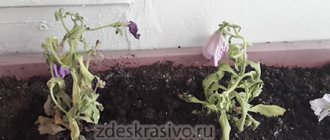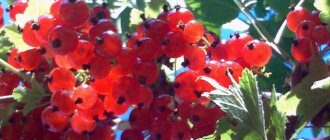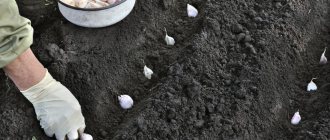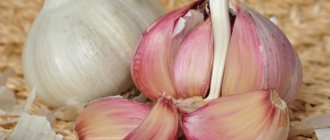When canning garlic, as well as other methods of cooking it, sometimes it turns blue. In a vinegar marinade, the spicy vegetable takes on a bluish and sometimes bluish-green tint, its appearance becomes unpleasant, and many people even have questions about whether it can be eaten. Why does this happen, and can this phenomenon be prevented? Are there any recipes for preparing pickled garlic and its culinary processing that prevent the appearance of an alarming, very unappetizing shade?
Biochemists have been researching these issues for a long time, they are ready to share their findings and give advice that will help all cooks.
Why garlic turns blue when canned: historical information
Mass industrial processing of garlic, which arose in American factories in the 50s of the last century, added to the worries of biochemists. The fact is that the standard scheme for turning the garlic harvest into canned puree (grinding - mixing with salt and vinegar - packaging in containers - sterilization and rolling) once failed: huge volumes of the finished product were written off and not allowed for sale as a result of its turning blue.
The gastronomic incident triggered a series of biochemical research efforts, during which scientists discovered why garlic turns blue in marinade.
Specifics of Chinese garlic
Experienced housewives have probably noticed that the spicy vegetable began to change color intensively only in recent years. This is due to the fact that instead of our “native” product, we switched to garlic from China, the world’s largest producer today.
But there is no need to immediately blame the farmers of the Middle Kingdom for dishonesty. Their garlic is not a genetic modification or the result of excessive use of chemicals. It’s just that this medicinal vegetable, grown in the southern regions, including East Asia, is much richer in alliin than its northern “brother.” It is not surprising that garlic collected from our summer cottages or bought from grandmothers at the market changes color extremely rarely, unlike the Chinese garlic that fills supermarkets.
In addition, southern garlic is fully ripe at the time of harvest, while we harvest it slightly unripe.
However, based on the fact that it is alliin that initiates the formation of allicin, a substance with the strongest anti-cancer, immunostimulating and bactericidal properties, we can conclude that Chinese garlic is more beneficial than ours. Although the conditions for growing the product are very important here.
Bottom line: there is no need to be afraid of Chinese garlic; in any case, as it turns blue or green, it does not become worse or more dangerous.
Times change, and with them, products familiar to us from childhood acquire different properties. Fortunately, new does not mean worse, as is the case with garlic. But if you want to avoid pigmentation of this vegetable, this is not at all difficult to do, observing the correct storage and processing conditions.
Biochemists say...
The scientific basis for the blueness of garlic in a vinegar marinade is as follows: the color transformations of garlic during the canning process are due to the release of essential oil components and enzymes as a result of the destruction of vegetable tissue. A representative of the latter, alinases, leads to the decomposition of alliin, which entails the process of dividing essential oils into sulfates and sulfides.
Organic compounds form:
- thiol, ammonia and pyruvic acid - as a result, garlic acquires an unpleasant odor;
- pigments that give garlic its blue-green color.
What does this mean for the average cook?
How do spices and seasonings affect color change?
Some spices and seasonings used for pickling can cause the appearance of a blue-green, dark gray hue. Similar phenomena tend to occur when adding to preservation:
- cinnamon;
- carnations;
- ground black pepper.
Mixtures consisting of several varieties of spices, seasonings, and spicy vegetables can affect the color of a vegetable. In such cases, a chemical process occurs consisting of the interaction of various ingredients of the dish.
It is important to understand that herbal spices and seasonings contain natural coloring substances that are not dangerous to humans.
Preventing garlic from turning blue in marinade
Have you tried a dozen recipes for canning tomatoes for the winter, but the garlic still turns blue? The main reasons for this phenomenon are not hidden in the cooking recipe at all - the coloring process is determined by factors such as the maturity of the product and the conditions in which the garlic was grown and stored.
An important factor is the conditions under which it was heat treated.
How to prevent blue nails?
Many problems can be easily avoided by following preventive measures. And blue nails are no exception. What can you do to keep your fingernails and toenails healthy, retain their natural color, and not break, crumble, or peel?
- Use individual tools for manicure or pedicure, wipe them with an antiseptic before the procedure;
- Trim your nails correctly: on the feet - at a right angle, on the hands - with a rounded edge;
- Choose comfortable shoes made from natural, breathable materials. Make sure that the big toe does not rest against the toe of the shoe and that the nail on it does not bend. In summer, to minimize the risk of accidental injury, wear closed-toe shoes;
- Keep your feet clean, dry, warm;
- In cold weather, wear gloves and warm, spacious shoes to prevent your hands or feet from freezing;
- Be careful when working with heavy objects, cutting tools, drawers, doors;
- When contacting household chemicals, use protective gloves;
- To prevent and early detect nail diseases, get a medical manicure and pedicure every six months;
- Choose high-quality decorative varnishes, nail care products, and hand skin care products.
Treat your nails carefully, care for and protect them, check their condition with a podiatrist. As we found out, some causes of blue nails are not dangerous and the problem goes away on its own. And in some cases, you cannot do without medical help.
To avoid complications, it is important to use it in time
No more questions about why garlic turns blue in marinade: canning secrets
So, the release of blue-green pigment is due to a slightly acidic environment in which amino acids are present. Our culinary goal is to reduce the effects of alliin. What actions need to be taken to prevent garlic from turning blue?
- Give preference to garlic, which originates from northern latitudes. The fact is that vegetables grown in southern latitudes are distinguished by a high content of allyl sulfide, the enzyme responsible for the intense color of garlic.
- If you are wondering why garlic turns blue when canned, then it is likely that when selecting products for preparing winter preparations, you chose not young and freshly picked garlic, but old and aged garlic. And since the latter is characterized by a high concentration of alliin, its pigmentation is stronger than the coloring of a fresh vegetable.
- Storing garlic in the right conditions will help prevent garlic from turning blue. So, the vegetable must be stored at room temperature (from 20 to 25 degrees) - by following this rule, you can prevent the active accumulation of alliin that occurs during storage at low temperatures (1-5 degrees Celsius).
- However, it is important to note that canning should be stored at low temperatures - this way the garlic will definitely not turn blue by the time it needs to be opened.
- The intensity of alliin pigmentation depends on the temperature at which vegetables are pickled or preserved. So, in order to preserve the pleasant appearance of pickles, chefs recommend preparing food for the winter in a cold way.
- When peeling garlic heads, try to be as careful as possible: the less damage on the surface of the vegetable, the less risk of ending up with blue-green garlic.
Universal advice that will help you forget about the question: “Why does garlic turn blue in the marinade?”
Culinary experts recommend: regardless of the conditions in which the garlic was grown, stored or processed, soaking it for three hours in cold water prevents any type of garlic from turning blue!
Pickled garlic turned blue: reasons
When preparing garlic for the winter, as a rule, housewives prefer to use the pickling method, as a result of which they may see blue cloves of garlic in the jar.
- First of all, violations of the structure of garlic are noted, that is, its mechanical damage. If you want to marinate this product efficiently, the cleaning process must be done manually, without using a knife. Then you will not observe such a phenomenon as garlic turning blue in jars.
- The second reason may be heat treatment. If garlic turns blue in the marinade, this is explained by the fact that during the hot pickling method, alliin decomposes. Especially if the environment is slightly acidic. This environment will only exist if the brine contains vinegar. This increases the likelihood that the garlic cloves will take on a slightly different color. The effect of the blue color of the cloves will be even stronger if, after sterilization, you wrap the jars of garlic with a blanket. There is a way out of this, you just need to use a cold marinade. It is also recommended to blanch the garlic cloves for three minutes.
- Another reason why garlic turns blue in brine may be that the garlic fruit is too ripe. This is justified by the fact that the young product almost does not contain the enzyme alliin. It also contains a small amount of essential oil. Due to this, young garlic is intended for all types of preservation. If you take young garlic and put it in the refrigerator for a long time, it will absorb the very enzyme that causes the blue color. It is best to store garlic in the pantry and do it at a temperature of 18 to 25 degrees.
Blue garlic is safe!
Indeed, blue-colored garlic “doesn’t lack for attractiveness.” However, scientists have found that alliin is a harmless substance, so consuming a pigmented product will not negatively affect human health. Moreover, in southern countries where garlic grows with a high concentration of the coloring enzyme, no one pays attention to the coloring of the vegetable and the question of why garlic turns blue in the marinade is not asked.
Thus, eating blue garlic is absolutely safe! Enjoy, first of all, the taste, not the appearance of the dish.
How to cook: step-by-step instructions
- Sort and wash vegetables and herbs. Choose small cucumbers (gherkins are fine). Take a young head of garlic - clean it of dry scales, but do not separate it into cloves. This way, the beneficial phytoncidal substances of the vegetable will be preserved to a greater extent.
- Rinse and sterilize the jar and lid with boiling water or boiling steam. You can do this like this: pour boiling water into a jar that has been washed with warm water, after 2-3 minutes, pour it out and fill the jar. Keep the lid in a saucepan of boiling water until the appetizer is sealed.
- Place the garlic and cucumbers tightly into the jar. Place dill and horseradish on top.
- Add aspirin and salt.
- Pour the prepared boiling water over the vegetables and immediately preserve with a lid.
- Set aside to cool at normal room temperature. Then go down to the basement or cellar. Do not store the workpiece in a warm place.
https://www.youtube.com/watch?v=DEFEnLfh1gM
Are you still wondering why garlic turns blue when pickled? Proper processing of the vegetable and preservation, its storage in a cool room will not allow this!
Tags: preservation, why, turn blue, garlic
How to pickle correctly so that garlic retains its color
To prevent pickled garlic from turning blue, it is recommended during the preparation process:
- choose young, not fully ripened garlic heads;
- peel the vegetable partially, without touching the elastic skin adjacent to the cloves;
- leave the tails and tips of the slices intact.
Using the dry method helps to avoid turning blue. When canning heads or slices without adding other vegetables, the product is placed in clean sterile jars (or wooden containers), sprinkled with salt and spices (brine is not used).
When preparing vegetable pickles, it is recommended to use a cold saline solution. The use of boiling water does not help preserve the color of the garlic cloves and may lead to the appearance of blue or greenish pigmentation.
A simple recipe for preparing the marinade, described below, will help you avoid turning the garlic product blue. It can be used for preparing any types of salted vegetables.
You should have at hand:
- heads of garlic - 10 pcs.;
- hot pepper - 3-4 pods;
- laurel leaves - 2-3 pcs.;
- vinegar - 2 tbsp. l.;
- sugar, salt - 30 g each;
- black peppercorns.
The garlic cloves are carefully peeled. Next, finely chop the pepper. Both products are thoroughly washed with a hot solution (2 liters of water + 2 tablespoons of salt).
At the next stage, the marinade is prepared. Add bay leaf, 10 black peppercorns, salt, sugar, spices to 700-800 ml of water. The mixture is brought to a boil and cooled until warm. Next, the vegetables are placed in sterilized jars, poured with marinade, and tightly rolled up with lids. The containers are turned upside down and left to cool.
Ready preserves should be stored in cool, dark corners of the house. Vegetables will be completely marinated after 2 weeks.
If all the points are done correctly, there will be no chance that the garlic will change color. The low temperature of the brine used for canning vegetables will prevent the decomposition of alliin, and the product itself will not lose its appetizing appearance.
It’s rare for a housewife to live without garlic in the kitchen. The spicy vegetable adds taste and aroma to dishes, thanks to its antimicrobial properties it enhances the body's defenses, it improves the taste of marinades and sauces, and is used fresh, pickled and salted. Today, consumers are increasingly complaining that the slices change color after cooking. Why garlic may turn blue during pickling remains to be seen.
Video
In this video you will find a simple recipe for pickling garlic from a professional.
Time passes, and tastes change with each generation of people. It is necessary to understand that new is not bad, but good. The same principle should be used in the case of garlic. You can easily prevent garlic from turning blue, the main thing is to follow all the rules.
It’s rare for a housewife to live without garlic in the kitchen. The spicy vegetable adds taste and aroma to dishes, thanks to its antimicrobial properties it enhances the body's defenses, it improves the taste of marinades and sauces, and is used fresh, pickled and salted. Today, consumers are increasingly complaining that the slices change color after cooking. Why garlic may turn blue during pickling remains to be seen.
The main reasons why garlic turns blue or green
Scientists from various countries became interested in the changes in the color of garlic that occur in the marinade several years ago. In the process of repeated experiments, several important points emerged. Researchers have identified the steps in the process, which is a complex chemical reaction, and leads to the blueness of this product:
- when the integrity of the cloves is damaged, the essential oils and enzymes included in its composition participate in active reactions;
- the alinase enzyme causes the decomposition of alliin (the substance that provides the pungent garlic taste);
- as a result of the breakdown of alliin, some essential oils provoke the appearance of sulfates and sulfides;
- the latter form special pigments that lead to the appearance of atypical colors.
Another common factor that can cause a spicy vegetable to turn blue or green after seaming is the presence of considerable amounts of copper in it. This metal tends to decompose in an acidic environment and cause bluish spots to appear on garlic cloves.
Vegetables also tend to turn blue or green:
- With broken integrity.
- Subjected to pre-heat treatment.
- Incorrectly stored before pickling (if the product has been in the refrigerator for a long time, the alliin content in it increases, and therefore it is recommended to place the garlic in the pantry at a temperature of +18 to +25ºС).
- Having a high degree of maturity (young garlic contains a small amount of alliin and essential oil compounds, the presence of which provokes pronounced chemical reactions).
Attentive housewives have noticed that foreign (Chinese) garlic tends to change color in tomatoes or in a jar of cucumbers. Domestic vegetables, as a rule, tolerate the harvest without any transformations, completely retaining their usual color and appearance.
Is it possible to eat it?
As it becomes clear, none of the reasons affects the quality of conservation. The color change does not affect the taste of pickled garlic. A blue product is safe for health; it can only slightly spoil the appearance of the vegetable. Therefore, pickled garlic that has changed color can be eaten completely calmly . It is aromatic, it is healthy and it is tasty, not only as an addition to the main dish, but also as an independent ingredient.
Cooking tricks
To make food look more aesthetically pleasing (without green or blue spots of garlic), housewives use the following culinary “life hacks”:
- Only young garlic is used in cooking;
- when marinating or salting, peel the slices with your fingers;
- The teeth are pickled exclusively in a cold way, the marinade is not subjected to heat treatment;
- keep the preserves cool;
- dried garlic is added to hot dishes;
- fresh garlic is added when frying or baking at the very end of cooking.
Causes of bad odor
The decay products can be felt by a person himself. An ordinary housewife may be frightened by an unpleasant smell. Do not empty a jar full of cucumbers or tomatoes. There is no need to recycle anything. The unpleasant smell and color do not pose any threat to human health. Vegetables do not lose their properties or taste when pickled.
The equally popular question about blue garlic, why it has an unpleasant odor, also has explanations. Scientists confirm that the strong unpleasant odor that the vegetable may have is associated with the release of ammonia and thiol. But, their dose is completely safe for humans. And unnatural color is a phenomenon that cannot be predicted.
( 2 ratings, average 4.5 out of 5 )
Common Theory
Why does homemade garlic turn blue when preserved and processed? The version considered by everyone is that this product contains a certain amount of ordinary copper. In certain cases, copper enters an acidic environment, which causes an acute reaction. After this, a fairly global change in the shade of garlic occurs. This reaction can be expected with ordinary vinegar, which is present in almost all recipes for pickling and preserving foods.
Blue garlic with pickled cucumbers
There is a theory that the amount of copper in garlic directly depends on certain factors: variety, cultivation, soil, degree of ripening of the bulb, use of fertilizer, area of growth.
Scientists' version
What do experts say on this issue? There is a whole theory that was put forward by chemists, and also confirmed by a variety of studies and experiments. When the integrity of the lobules is compromised, the following gradually begin to emerge from tissues damaged by processing:
- essential thick oil;
- enzymes.
Under the influence of a special enzyme, an active chemical reaction immediately begins, which gradually leads to the destruction of alliin, which provokes the formation of essential oil particles. Then the new element begins to react to the amino acids of the product and creates certain shades - blue, green, green-blue. Then the lobules are stained evenly or partially.
Shades of garlic can range from yellow to green and dark blue
Why else does garlic turn blue? There are several factors that indicate a direct influence on the course of all reactions: the process is significantly accelerated and reacts to the presence of amino acids in the case of an ambient temperature of 45-80 degrees.
The degree of brightness of the pigment shade and the intensity of its formation almost does not depend on the selected variety of garlic. But it directly depends on the growing conditions, the stage of ripening at the time of harvesting, and its further storage. That’s why garlic turns blue unpredictably – the process cannot be predicted.
Garlic may also turn blue during storage.
Scientists were able to establish that all the minerals that each lobe includes: copper, iron, manganese, aluminum, zinc or chromium do not affect this chemical reaction. We can conclude that all the elements from the chemical table are not able to directly affect the degree of blueness of garlic in the marinade.
Blue garlic in a jar with canned cucumbers
We can conclude that absolutely any garlic can change its color, which does not depend in any way on the country of origin or the variety itself.
The main task is proper storage, consumption, use and preparation.
Why garlic begins to change color has become more clear. How to avoid this effect in order to reduce the likelihood of garlic cloves turning blue?
Turning blue just in air for 24 hours - experiment
Rules
It is required to process the product correctly, then you reduce the risk of changing the shade of this product:
- A young root vegetable, which contains little alliin, healthy proteins and various volatile compounds, but a lot of high concentration sugars, when pickled or salted, almost never changes its hue to green or blue. For the pickling recipe, it is better to purchase an immature and young product and collect it from home garden beds in advance. It is also known that young heads turn out much tastier and juicier in their finished form.
- It is recommended to use a still young and almost ripened product when preserving homemade or purchased zucchini, cucumbers or squash.
- When preparing any marinade recipe, do not damage the garlic cloves, so do not use sharp knives, but do everything with your hands.
- The fruit should be added to the prepared dish at the end of the process, or even better, just before serving the food.
- Use already dried garlic in cooking, then you will not have any unpleasant tint effect on the cloves.
- To effectively and efficiently avoid tinted spots on garlic, you do not need to immediately add them to marinades or preserves with mushrooms. It is recommended to chop and add pieces of garlic to ready-cooked mushrooms just before serving them to guests or family.
Canned garlic does not always turn blue
If you follow all the rules and tips, you can avoid changes in the color changes of the slices. The judicious use of garlic will help transform the dish and its taste. It may also happen that the fruit eventually turns blue or green, since no one is immune from this, but you will minimize the risk of changing canned or fermented garlic in your original and tasty recipes.
Watch this video on YouTube
How to Avoid Greening
If the natural color of a vegetable is very important to you, and eating slices of an unnatural color is not very pleasant, you should familiarize yourself with the following subtleties of processing:
- Carry out pickling and canning of freshly picked, slightly unripe vegetables, as they contain the least amount of alliin.
- Follow the recommendations for storing raw vegetables and rolling them.
- Slowing down pigmentation is possible if, before further heat treatment or pickling, blanch the slices for 2 minutes and then immerse them in cold water.
- Peel the shell manually so as not to touch the slices.
- If you plan to cook garlic, pre-grated or chopped, lightly fry it before cooking.
- It is better to marinate the slices using a cold method (cold marinades).
- Fresh product must be served separately so that it does not react with other products.
Thus, garlic that changes color during heat treatment, pickling or canning is considered absolutely safe for consumption. To prevent the slices from changing color, it is recommended to follow the basic rules for their preparation and storage.
Variations of honey and garlic recipes
But, keep eating to stay healthy. Use honey. Use in cooking, tea, tonic or as cough syrup. Preserve berries in honey: Try preserving cranberries or blueberries in honey. These berries work best with their hard outer skin. Alternatively, use honey as a berry-flavored syrup.
I've recently been having problems with garlic in my dishes turning blue-green. What's going on here and does it make sense that it would change the taste? It turns out that the reactions that create this blue pigment are related to the reactions that create the familiar pungent aroma of garlic and onions. The chemical precursors to these compounds start out safely locked away in individual plant cells, but as you cut or harvest them, they are exposed to each other, where they eventually react via enzymes.
